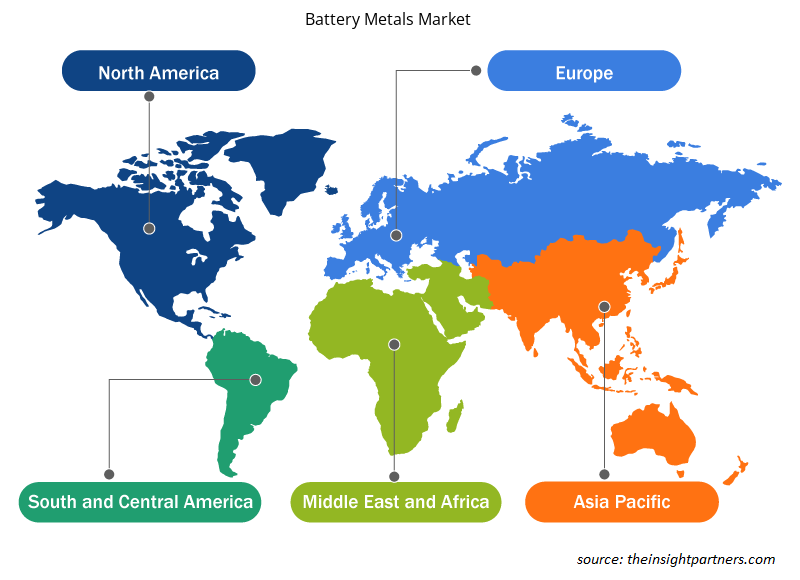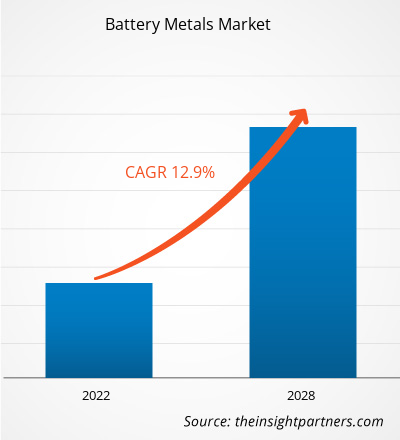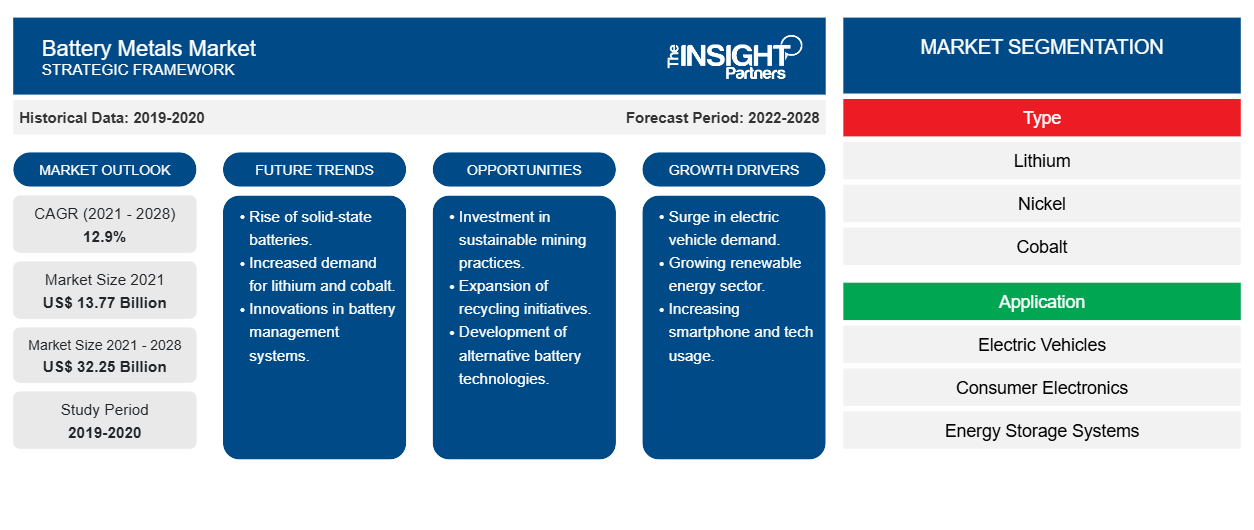[研究报告] 电池金属市场预计将从 2021 年的 137.709 亿美元增至 2028 年的 322.511 亿美元;预计 2021 年至 2028 年的复合年增长率为 12.9%。
锂、钴、镍和锰等电池金属是制造电池的原材料。这些金属还用于电动汽车、消费电子产品和其他应用。
2020 年,亚太地区占据了全球电池金属市场的最大收入份额。亚太各国的汽车和电子行业正在蓬勃发展,这可能会在预测期内继续推动电池金属市场的增长。此外,由于汽车和电子行业的快速发展,整个亚太地区的电动汽车市场也出现了显着增长。
定制此报告以满足您的需求
您可以免费定制任何报告,包括本报告的部分内容、国家级分析、Excel 数据包,以及为初创企业和大学提供优惠和折扣
-
获取此报告的关键市场趋势。这个免费样品将包括数据分析,从市场趋势到估计和预测。
COVID-19 疫情导致全球供应链中断。采矿业、化工和材料业等许多行业在实现各种商品的生产和交付计划以及销售方面面临着前所未有的挑战。然而,随着各经济体计划恢复运营,全球对电池金属的需求预计将上升。汽车、电子和其他行业的恢复运营增加了全球对电池金属的需求。随着消费者支出的激增,消费电子行业正在蓬勃发展。电动汽车、消费电子产品和储能系统等各种应用对电池金属的需求增加,以及知名制造商的大量投资预计将在未来几年推动电池金属市场的增长。
市场洞察
不断发展的电动汽车行业
全球电动汽车需求的激增推动了电池金属市场的增长。电动汽车行业广泛使用电池金属产品来替代运行汽车所需的化石能源。在人口密集的地区,电动汽车被广泛用于减少汽车污染,因为这些地区使用的汽车数量更多。这也是实现能源多样化和减少温室气体排放的重要因素。电动汽车的好处包括零尾气排放、温室气体减排潜力以及比内燃机汽车更高的效率。
中国、印度、美国等许多国家的政府都出台了鼓励使用电动汽车的法规。随着两轮车、三轮车、公交车和卡车的电动化技术不断进步,电动汽车及其市场正在大幅扩张。
根据国际能源署的《2020 年全球电动汽车展望》报告,2019 年全球电动乘用车保有量持续增长,达到 720 万辆,比 2018 年增长 40%。由于所有这些因素,对电动汽车/混合动力汽车和电动汽车/插电式混合动力汽车的需求正在增长。这反过来又极大地推动了电池金属市场的发展。
基于类型的见解
根据类型,电池金属市场细分为锂、镍、钴和其他。锂细分市场在 2020 年占据了最大的市场份额。该细分市场的增长可归因于锂因其重量轻的特性在电动汽车和电子行业中的应用日益增多。
基于应用程序的见解
根据应用,电池金属市场进一步细分为电动汽车、消费电子产品、储能系统等。电池金属市场以电动汽车细分市场为主,在预测期内复合年增长率最高。由于发达国家和发展中国家政府部门监管规范的变化,对无污染汽车的需求不断增加,对电池金属市场产生了巨大影响。
雅宝公司、优美科、LG 化学、赣锋锂业股份有限公司、巴斯夫 SE、Bolt Metals Corp.、Honjo Metal Co., Ltd.、Lithium Australia NL、淡水河谷和美卓奥图泰是电池金属市场的主要参与者。这些市场参与者专注于开发高质量和创新产品以满足客户要求。雅宝公司宣布在其位于北卡罗来纳州金斯山的工厂启动电池材料创新中心(BMIC)。该实验室生产锂金属阳极技术,通过使用先进的锂金属轧制技术将锂箔厚度减至 20 微米(即约为人类头发平均厚度的五分之一)或更薄,从而提高电池的能量密度。赣锋锂业旗下江苏赣锋电源科技有限公司正式迁入新工厂,并通过设备更换提高了产能。江苏赣锋以工业车辆锂电池系统为主导产品,为客户提供长寿命、高续航、免维护、可定制化的动力系统解决方案,推动工业车辆从铅酸电池向铁锂电池的迭代。
报告亮点
- 全球电池金属市场不断发展的行业趋势,帮助参与者制定有效的长期战略
- 发达市场和发展中市场采用的业务增长战略
- 2019 年至 2028 年全球电池金属市场定量分析
- 各行业对电池金属的需求估计
- 了解竞争激烈的市场形势和电动汽车需求的最新发展
- 市场趋势和前景以及推动和抑制电池金属市场增长的因素
- 通过了解支撑全球电池金属市场增长商业利益的战略来进行决策
- 电池金属市场各节点规模
- 全球电池金属市场的详细概述和细分以及行业动态
- 各地区电池金属市场规模及增长机遇
电池金属市场区域洞察
Insight Partners 的分析师已详细解释了预测期内影响电池金属市场的区域趋势和因素。本节还讨论了北美、欧洲、亚太地区、中东和非洲以及南美和中美洲的电池金属市场细分和地理位置。

- 获取电池金属市场的区域特定数据
电池金属市场报告范围
| 报告属性 | 细节 |
|---|---|
| 2021 年市场规模 | 137.7亿美元 |
| 2028 年市场规模 | 322.5亿美元 |
| 全球复合年增长率(2021 - 2028) | 12.9% |
| 史料 | 2019-2020 |
| 预测期 | 2022-2028 |
| 涵盖的领域 |
按类型
|
| 覆盖地区和国家 |
北美
|
| 市场领导者和主要公司简介 |
|
市场参与者密度:了解其对商业动态的影响
电池金属市场正在快速增长,这得益于终端用户需求的不断增长,而这些需求又源于消费者偏好的不断变化、技术进步以及对产品优势的认识不断提高等因素。随着需求的增加,企业正在扩大其产品范围,进行创新以满足消费者的需求,并利用新兴趋势,从而进一步推动市场增长。
市场参与者密度是指在特定市场或行业内运营的企业或公司的分布情况。它表明在给定市场空间中,相对于其规模或总市场价值,有多少竞争对手(市场参与者)存在。
在电池金属市场运营的主要公司有:
- 雅宝公司
- 螺栓金属
- 赣锋锂业有限公司
- 优美科
- LG化学
免责声明:上面列出的公司没有按照任何特定顺序排列。

- 获取电池金属市场顶级关键参与者概述
电池金属市场(按类型)
- 锂
- 镍
- 钴
- 其他的
电池金属市场(按应用)
- 电动汽车
- 消费电子产品
- 能源存储系统
- 其他的
公司简介
- 雅宝公司
- 优美科
- LG化学
- 赣锋锂业有限公司
- 巴斯夫
- 博尔特金属公司
- 本庄金属株式会社
- 澳大利亚锂业公司
- 谷
- 美卓奥图泰
- 美国元素
- 历史分析(2 年)、基准年、预测(7 年)及复合年增长率
- PEST和SWOT分析
- 市场规模、价值/数量 - 全球、区域、国家
- 行业和竞争格局
- Excel 数据集
近期报告
相关报告
客户评价
购买理由
- 明智的决策
- 了解市场动态
- 竞争分析
- 客户洞察
- 市场预测
- 风险规避
- 战略规划
- 投资论证
- 识别新兴市场
- 优化营销策略
- 提升运营效率
- 顺应监管趋势























 获取免费样品 - 电池金属市场
获取免费样品 - 电池金属市场